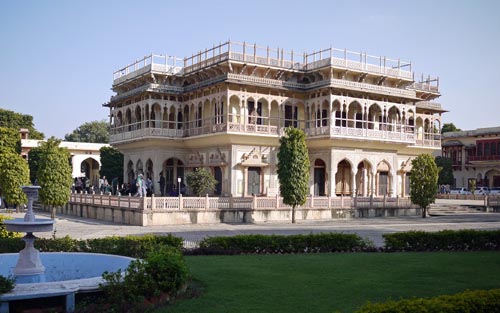Mubarak Mahal

Information on Mubarak Mahal (Jaipur, Rajasthan) - History & Architecture
Mubarak Mahal was established in the 19th century and it is also regarded as one of the most popular architectural innovation of India. It was developed by the aristocrats of Rajput leaders. Mubarak Mahal is also termed as 'Palace of Welcome' and was designed in order to welcome the royal visitors.
Mubarak Mahal Architecture
Mubarak Mahal was established by the blend of Islamic, Rajput and European architectural structures. It is a two storeyed mansion, having huge lodgings along with greeting hall. The mahal is decorated with attractive walls and frieze paintings. Mubarak Mahal also represent pleasant illustration of Hindu architecture embroidered with creatively imprinted screens, galleries, archways and brackets. It has stunningly engraved marble gate with dense brass doors. Beyond the entrance lies 'Hall of Private Audience' which is designed with marble gallery.
The creator of the mahal is Madho Singh II. Mubarak Mahal is basically a museum, having well fountain of ranges of fabrics such as royal formal clothes, embellished shawls and silk saris among others. Furthermore, the museum also comprise various attractive musical tools, Mughal glasses, hookah bases and pleasant toys for young royals. Its exterior is adorned with carved lace. One noteworthy display of Mubarak Mahal is set of huge garments worn by Sawai Madhosingh, who was about 3.9 feet tall and weighed about 250 kilogram.
Mubarak Mahal History
Mubarak Mahal is the first building of the City Palace and is closely associated with history of Jaipur city. Mubarak Mahal stands in the central of courtyard of City Palace, which was established during the sovereignty of Sawai Jai Singh from the period of 1699 to 1744. He changed the capital from Amber to Jaipur in the year 1727 due to population growth and growing water shortage. He planned to develop Jaipur city in six areas detached by comprehensive paths and one of the example of this development is Mubarak Mahal.
The Mubarak Mahal was established by descendent of Jai Singh namely Madho Singh II who ruled from 1880 to 1922. He was the last king who ruled from City Palace of Jaipur. However, even the end of his sovereignty, the palace continued to be a home of royal family. In the year 1900 he developed this guest house, whose design was inspired by 'Jeypore Arhitectural Portfolios'. During the first two periods of 20th century, Mubarak Mahal was used for welcoming royal guests. During this period, the renowned mats of Jaipur, royal Ramayana and weaponries were also demonstrated there. The relics of Mubarak Mahal were viewed and esteemed by several foreign royal visitors including King Edward and Queen Alexandria in the year 1911. Furthermore, Prince of Wales and Lady Mountbatten also appreciated the beauty of Mubarak Mahal in the year 1922. Afterwards, the mahal was served as museum.
Mubarak Mahal Tourism Importance
Mubarak Mahal has significant importance from tourism viewpoint as it stands for Mughal emperor's rule and Indian royal culture. It is a key portion of City Palace and developed as a guesthouse for royal families. At Mubarak Mahal, tourists can see diversity of fabrics and luxurious clothes, the kings of Jaipur used to wear. It was also recognised as one of the most lovely 20th century constructions by the international architects in the annual conference of Beijing in 1997, making it highly significant from the viewpoint of tourism. Its importance is well known to the world and if you are in Jaipur or get an opportunity to be in this Pink City, just don't miss the opportunity to witness the architectural beauty, which is incomparable and significant internationally.
- Andaman Nicobar Monuments
- Andhra Pradesh Monuments
- Assam Monuments
- Bihar Monuments
- Chhattisgarh Monuments
- New Delhi Monuments
- Goa Monuments
- Gujarat Monuments
- Haryana Monuments
- Himachal Pradesh Monuments
- Jammu and Kashmir Monuments
- Karnataka Monuments
- Kerala Monuments
- Madhya Pradesh Monuments
- Maharashtra Monuments
- Odisha Monuments
- Punjab Monuments
- Rajasthan Monuments
- Tamil Nadu Monuments
- Telangana Monuments
- Uttar Pradesh Monuments
- West Bengal Monuments